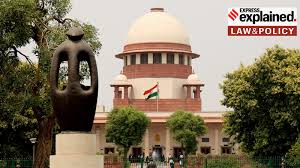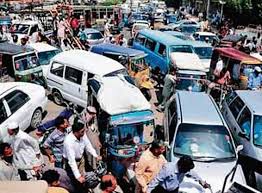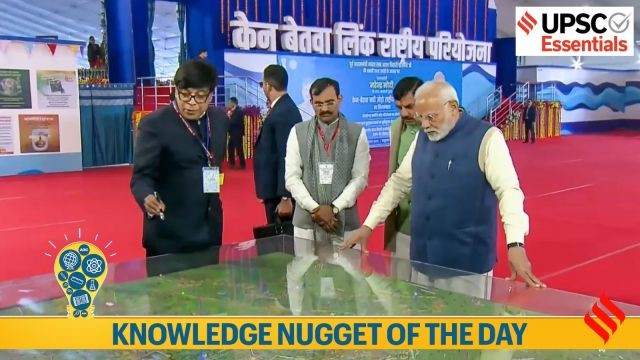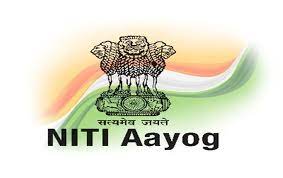Judiciary in Crisis and the Digital Transformation of India

- 23 Jan 2025
In News:
The Indian judiciary is grappling with an unprecedented backlog of cases, while India’s digital economy is witnessing exponential growth, promising to be a key driver of future economic expansion. Simultaneously, India's strides in the space sector and emerging technologies signal its increasing role as a global innovator.
The Crisis of Judicial Pendency in India
- Background: The Supreme Court recently permitted High Courts to appoint ad-hoc retired judges under Article 224A to address the mounting pendency of cases. This move revives a constitutional provision that had remained dormant, with only three recorded instances of its use.
- Scale of Backlog:
- As of January 2025, over 62 lakh cases are pending in High Courts.
- Nearly 4 crore cases are pending in subordinate courts.
- 30% of High Court judicial positions remain vacant.
- Reasons for Pendency
- Insufficient Judicial Strength: Low judge-to-population ratio.
- Infrastructure Deficit: Poor court facilities, especially in rural areas.
- Administrative Delays: Outdated systems and slow bureaucratic processing.
- Rising Litigation: Increase in public awareness and socio-economic issues.
- Adjournments & Procedural Delays: Inefficient court practices.
- Vacancies in Appointments: Delay in filling judicial posts due to the standoff between executive and judiciary.
Constitutional Provision: Article 224A
- Enables High Courts to appoint retired judges temporarily with the President’s consent.
- Judges appointed under this article have full powers and jurisdiction of a regular High Court judge.
- Supreme Court in Lok Prahari v. Union of India (2021) provided guidelines for such appointments, including limiting it to instances where judicial vacancies are not more than 20%.
Judicial Appointments Debate: Collegium vs. NJAC
- Collegium System
- CJI + Four senior-most judges decide appointments.
- Criticized for lack of transparency, nepotism, and non-accountability.
- National Judicial Appointments Commission (NJAC)
- Proposed inclusion of judiciary, executive, and civil society (2 eminent persons).
- Struck down by SC in 2015 to preserve judicial independence.
- Current Debate: Rising demands for a reformed NJAC to bring in accountability while retaining independence.
Global Models of Judicial Appointments
Country System Key Feature
UK Judicial Appointments Commission Transparent, includes laypersons
South Africa Judicial Service Commission Diverse representation: judiciary, politicians, academics
France High Council of Judiciary Balanced approach with civil society input
Impacts of Judicial Delay
- Delayed Justice: Undermines public trust.
- Overcrowded Prisons: Over 70% of inmates are undertrials; prisons operate at 114% capacity.
- Economic Costs: Delays in dispute resolution hamper business environment and economic efficiency.
- Judicial Burnout: Overburdened judges impact quality of judgments.
Addressing Judicial Pendency
- Short-Term Measures
- Appointment of Ad-Hoc Judges under Article 224A.
- Fast Track Courts for specific offenses (e.g., crimes against women, corruption).
- Long-Term Reforms
- Reforming Judicial Appointments: Transparent and accountable system through restructured NJAC.
- Enhancing Collegium Transparency: Clear criteria and public disclosure.
- Promoting ADR Mechanisms: Arbitration, mediation, and conciliation to reduce court burden.
- Judicial Infrastructure Development: More courtrooms, modern facilities, and digitalization.
Way Forward
Judicial Reform
- Strengthen judicial accountability while maintaining independence.
- Incorporate global best practices in appointment systems.
- Promote Alternative Dispute Resolution (ADR) and digitization of court processes
Why Indian cities need Behavioral Change Officers

- 21 Jan 2025
Urban India at a Crossroads
India's urban population is projected to reach 40% by 2030, up from 30% in 2011. While this urban surge brings opportunities for economic and social progress, it also amplifies challenges such as:
- Infrastructure strain
- Environmental degradation
- Social inequality
- Climate impacts—including increased frequency of floods, heatwaves, and climate-driven migration
Traditionally, governments have relied on a combination of policy reforms, infrastructure investment, and technological advancements. However, a crucial component is often overlooked: behavioral change.
The Case for Behavioral Change in Urban Governance
Urban planning and service delivery frequently overlook how citizen and provider behavior shapes outcomes. Sustained, meaningful change requires more than just awareness campaigns—it demands behaviorally-informed governance. Here's why:
- Enhancing Service Delivery: Cities like Indore showcase how behavior change can revolutionize urban systems. Once struggling with waste management, Indore became India’s cleanest city through:
- Door-to-door campaigns
- Strict enforcement of segregation rules
- Viral initiatives like the ‘Kachra Gadi’ song to shift mindsets
- Driving Sustainability: In cities like Delhi, the odd-even vehicle rule led to a 30% reduction in traffic congestion by using simple default behavioral triggers. When people opt for public transport or energy conservation, it reduces emissions and eases city operations.
- Improving Public Safety: Behavioral strategies also improve law enforcement and community trust. For instance, Kerala’s ‘Janamaithri Suraksha’ program emphasizes empathetic policing, resulting in stronger police-citizen relations.
- Boosting Institutional Efficiency: Embedding behavioral insights can improve the efficiency of government schemes. The NITI Aayog’s Behavioral Insights Unit and initiatives in Uttar Pradesh and Bihar demonstrate success in using nudges to improve outcomes in areas like maternal health and welfare delivery.
Why Cities need Chief Behavioral Officers (CBOs)
To embed these insights systematically, Indian cities must institutionalize behavioral science through dedicated roles like Chief Behavioral Officers (CBOs) within Urban Local Bodies.
CBO Functions:
- Integrate behavioral strategies into urban planning
- Design evidence-backed nudges and campaigns
- Collaborate with stakeholders, municipal officers, and researchers
- Guide data-driven policy experimentation
Support Structure:
- A small team of behavioral fellows
- Annual Behavioral Plans aligned with city goals
- Investment in citizen engagement platforms
- Use of big data and surveys to uncover behavioral bottlenecks
Examples from global cities like New Orleans (via What Works Cities) show that CBOs can drive change quickly and cost-effectively.
Challenges to Behaviorally-Informed Urbanism
Despite its promise, this approach faces several roadblocks:
- Cultural inertia and resistance to change (e.g., reluctance in waste segregation)
- Lack of training in behavioral science among officials
- Resource constraints in smaller municipalities
- Fragmented coordination between departments (e.g., transport, sanitation)
Way Forward
To overcome these challenges, cities must:
- Institutionalize behavioral roles in governance structures
- Partner with behavioral scientists and think tanks
- Leverage technology (e.g., mobile apps for citizen feedback)
- Scale successful pilots (e.g., Indore’s waste model) across regions
This structured approach not only improves efficiency and citizen satisfaction, but also reduces the costs of service delivery, allowing long-term savings.
River Interlinking in India

- 18 Jan 2025
Context:
India, with 17% of the world’s population but only 4% of its freshwater resources, faces significant water distribution challenges. The ambitious river interlinking project aims to mitigate regional water imbalances by transferring water from surplus areas to water-deficient regions, addressing irrigation, drinking water supply, flood control, and overall development.
Background and Evolution
The idea of interlinking rivers dates back to 1858 when British engineer Captain Arthur Cotton proposed linking rivers for inland navigation. Post-independence, Dr. K.L. Rao (1972) suggested the ‘Ganga-Cauvery Link Canal,’ followed by Captain Dinshaw J. Dastur’s ‘National Garland Canal’ proposal in 1977. However, these were deemed infeasible. In 1980, the Ministry of Water Resources formulated the National Perspective Plan (NPP), identifying 30 river link projects—14 under the Himalayan component and 16 under the Peninsular component.
The National Water Development Agency (NWDA) was established in 1982 to study and implement these projects. The Supreme Court, in response to a PIL in 2002, directed the government to expedite the completion of interlinking projects.
Ken-Betwa Link Project (KBLP)
The first project under the NPP, the Ken-Betwa Link Project (KBLP), was inaugurated on December 25, 2024. It aims to provide irrigation to Bundelkhand, one of India’s most drought-prone regions, by transferring surplus water from the Ken River in Madhya Pradesh to the Betwa River in Uttar Pradesh. Covering 10.62 lakh hectares of land (8.11 lakh ha in MP and 2.51 lakh ha in UP), the project will supply drinking water to 62 lakh people and generate 103 MW of hydropower along with 27 MW of solar power. However, environmental concerns persist as it passes through the Panna Tiger Reserve.
Significance of River Interlinking
- Water Redistribution: The scheme will transfer about 200 billion cubic meters (BCM) of water annually to water-scarce regions, ensuring equitable distribution.
- Agricultural Benefits: It will irrigate approximately 34 million hectares of farmland, enhancing food security and increasing agricultural productivity.
- Hydropower Generation: An estimated 34,000 MW of hydropower will be generated, supporting renewable energy expansion.
- Flood and Drought Mitigation: Excess water will be stored in reservoirs, reducing flood risks while ensuring availability during droughts.
- Economic Growth: Improved water availability will boost industries, generate employment, and aid in rural development.
Environmental and Social Concerns
- Ecological Disruptions: Altering river morphology can impact sediment transport, water quality, and aquatic ecosystems.
- Biodiversity Loss: Dams and canals may disrupt fish migration patterns and submerge forests, leading to biodiversity depletion.
- Climate Impact: Water transfer may affect regional climate attributes, altering temperature, precipitation, and humidity levels.
- Displacement and Social Issues: Large-scale projects often lead to displacement of communities, causing resettlement challenges and conflicts over compensation.
- Economic Viability: High project costs and potential delays raise concerns about financial feasibility compared to alternative solutions like rainwater harvesting and local water conservation.
Conclusion
While river interlinking presents a potential solution to India’s water crisis, it must be carefully assessed against environmental and social impacts. Sustainable water management strategies, such as efficient irrigation techniques and localized conservation methods, should complement large-scale projects to ensure a balanced approach to water security and development.
Digital Governance in India

- 16 Jan 2025
In News:
India is making significant strides toward digital governance, an initiative aimed at enhancing both citizen services and the capabilities of government employees. This transition to a digitally-driven framework is designed to improve the efficiency, transparency, and accountability of government operations, positioning India as a global leader in modern governance practices.
What is Digital Governance?
Digital governance refers to the application of technology to enhance the functioning of government processes. By integrating digital tools and platforms, it aims to streamline administrative operations, reduce inefficiencies, and improve public service delivery. This approach also extends to ensuring greater transparency and accountability in government dealings.
Key Initiatives in Digital Governance
India has launched several critical initiatives to modernize governance through digital means. Some of the key programs include:
- iGOT Karmayogi Platform: The iGOT Karmayogi platform is a government initiative to provide online training to public employees. It aims to enhance public administration skills, foster expertise in data analytics, and equip employees with the necessary tools in digital technologies. This initiative aims to prepare government personnel to handle the challenges of a digitally evolving governance landscape.
- e-Office Initiative: The e-Office program is designed to reduce paper-based work by digitizing workflows within government departments. This initiative facilitates real-time communication among offices and ensures more efficient and transparent management of tasks. It also helps streamline decision-making processes and improves the speed of governance operations.
- Government e-Marketplace (GeM): The Government e-Marketplace (GeM) is an online platform developed to optimize procurement processes. It allows government agencies to procure goods and services efficiently, transparently, and with accountability. This platform has contributed to reducing corruption and ensuring that government purchases represent the best value for public money.
- Cybersecurity Training for Employees: As digital operations increase, ensuring the safety of sensitive data is paramount. The cybersecurity training program for government employees is designed to enhance their ability to recognize and respond to potential cyber threats. This initiative ensures data protection, safe online practices, and cyber resilience across digital governance platforms.
Challenges in Implementing Digital Governance
Despite its benefits, India faces several challenges in the successful implementation of digital governance. These obstacles must be addressed to unlock the full potential of technology-driven governance.
- Resistance to Technological Change: One of the key barriers to digital transformation in government is the resistance among employees to adopt new technologies. Many government officials remain accustomed to traditional, paper-based processes and are reluctant to transition to digital systems due to concerns about complexity and job security.
- Digital Divide in Rural Areas: While urban regions in India have better access to high-speed internet and digital infrastructure, many rural areas face significant digital divide challenges. Limited access to technology hampers the successful implementation of digital governance in these regions, restricting equitable service delivery across the country.
- Cybersecurity Risks: The rise of digital operations in governance increases the risk of cyberattacks and data breaches. With government data being digitized, the threat of cybercrimes becomes more pronounced, making it critical to implement robust cybersecurity measures and data protection strategies to safeguard sensitive information.
- Lack of Incentives for Training Outcomes: Although government employees are encouraged to take part in training programs such as iGOT Karmayogi, the absence of clear incentives to complete these programs can undermine their effectiveness. Establishing tangible rewards or career progression linked to the successful completion of training would encourage employees to fully engage in capacity-building initiatives.
Solutions to Overcome Challenges
To ensure the success of digital governance, several strategies must be put in place to address the challenges identified.
- Foster Innovation-Friendly Environments: Promoting an innovation-friendly culture within government offices can help reduce resistance to new technologies. Encouraging employees to engage with digital tools, offering regular training, and providing ongoing support will facilitate a smoother transition to a technology-driven governance system.
- Invest in Digital Infrastructure for Rural Areas: Addressing the digital divide requires significant investment in digital infrastructure in rural and remote areas. Ensuring that these regions have reliable internet access and the necessary technological resources will empower citizens across India to benefit from digital governance.
- Continuous Capacity-Building Programs: Establishing continuous training programs for government employees will ensure that they remain up-to-date with the latest technological trends. Regular updates to training content will help employees stay prepared to handle emerging challenges in digital governance.
- Strengthen Cybersecurity Protocols: To mitigate cybersecurity risks, it is essential to implement stringent cybersecurity measures across all levels of government operations. This includes regular cybersecurity awareness programs, proactive threat management systems, and rigorous data protection protocols to safeguard both government data and citizens’ personal information.
Conclusion
India’s shift towards digital governance represents a significant step toward modernizing administrative systems, enhancing transparency, and improving service delivery to citizens. However, challenges such as resistance to change, the digital divide, cybersecurity risks, and the lack of clear incentives for training must be addressed. By investing in digital infrastructure, offering continuous training programs, and reinforcing cybersecurity measures, India can create an effective and secure framework for digital governance that benefits both its citizens and the government workforce.
NITI Aayog Celebrates 10 Years

- 06 Jan 2025
In News:
- NITI Aayog, the National Institution for Transforming India, completed its 10th anniversary on January 1, 2025.
- Established to replace the Planning Commission, NITI Aayog was designed to address contemporary challenges such as sustainable development, innovation, and decentralization in a dynamic, market-driven economy.
About NITI Aayog
Establishment and Mandate
- Formation: Created through a Union Cabinet resolution in 2015.
- Primary Mandates:
- Overseeing the adoption and monitoring of the Sustainable Development Goals (SDGs).
- Promoting competitive and cooperative federalism between States and Union Territories.
Composition
- Chairperson: Prime Minister of India.
- Governing Council: Includes Chief Ministers (CMs) of all States and UTs, Lt. Governors, the Vice Chairperson, full-time members, and special invitees.
- CEO: Appointed by the PM for a fixed tenure.
Key Achievements
Policy Advisory and Decentralized Governance
- Shifted focus from financial allocation to policy advisory roles.
- Promoted decentralized governance through data-driven initiatives like the SDG India Index and the Composite Water Management Index.
Innovative Initiatives
- Aspirational Blocks Programme (2023): Focused on 500 underdeveloped blocks for 100% coverage of government schemes.
- Atal Innovation Mission (AIM): Trained over 1 crore students through Atal Tinkering Labs and incubation centres.
- Initiatives like e-Mobility, Green Hydrogen, and the Production-Linked Incentive (PLI) Scheme were conceptualized to drive innovation and sustainability.
Role and Functions of NITI Aayog
Strategic Advice and Federal Cooperation
- Provides policy formulation and strategic advice to both central and state governments.
- Fosters cooperative federalism by encouraging collaboration between the central and state governments.
Monitoring and Evaluation
- Plays a crucial role in monitoring and evaluating policies and programs to ensure alignment with long-term goals.
Promoting Innovation and SDGs
- NITI Aayog contributes to aligning national development programs with the Sustainable Development Goals (SDGs), focusing on innovation, research, and technology in critical sectors.
Key Differences Between Planning Commission and NITI Aayog
Aspect Planning Commission NITI Aayog
Purpose Centralized planning and resource allocation. Focus on cooperative federalism and policy research.
Structure Led by the PM, with Deputy Chairman and full-time members. Led by the PM, with Vice-Chairperson, CEO, and Governing Council.
Approach Top-down, centralized. Bottom-up, encouraging state participation.
Role in Governance Executive authority over policies. Advisory body without enforcement power.
Five-Year Plans Formulated and implemented. Focus on long-term development, no Five-Year Plans.
Challenges Faced by NITI Aayog
- Limited Executive Power: Lacks authority to enforce its recommendations, restricting its influence.
- Coordination Issues: Achieving effective collaboration between central and state governments remains challenging.
- Data Gaps: Inconsistent state-level data hampers accurate policymaking and evaluation.
- Resource Constraints: Limited resources hinder full implementation of initiatives.
- Resistance to Change: Some states resist NITI Aayog's initiatives due to concerns over autonomy and alignment with local needs.
Future Vision and Planning
- Agenda for 2030: Focus on achieving the Sustainable Development Goals (SDGs) in areas like poverty alleviation, education, healthcare, clean energy, and gender equality.
- Vision for 2035: NITI Aayog's 15-year vision document aims for sustainable, inclusive growth, with an emphasis on economic growth, social equity, and environmental sustainability.
- Innovation and Digitalization: Promotes digitalization and innovation through data-driven policymaking and regional focus on tribal and hilly areas.
Conclusion: Reflections on the First Decade
- Despite significant achievements, NITI Aayog’s influence remains limited by its advisory role and resource constraints.
- The shift away from centralized planning, evident since the dissolution of the Planning Commission, has sparked debate about the effectiveness of such a model in ensuring long-term development and inclusive growth.
Suposhit Gram Panchayat Abhiyan

- 26 Dec 2024
In News:
On December 26, 2024, Prime Minister Narendra Modi presided over the Veer Bal Diwas celebrations at the Bharat Mandap in New Delhi. This annual event commemorates the martyrdom of the sons of Sri Guru Gobind Singh Ji and highlights the importance of nurturing the next generation. During the occasion, PM Modi also launched the ‘Suposhit Gram Panchayat Abhiyan,’ an initiative aimed at improving nutrition and well-being in rural India.
Veer Bal Diwas: Commemorating Sacrifice and Courage
Veer Bal Diwas was declared on January 9, 2022, by PM Modi to honor the sacrifices made by the young sons of Guru Gobind Singh Ji — Sahibzada Baba Zorawar Singh and Baba Fateh Singh — who were martyred in 1704. During the Mughal-Sikh battles, these two brave boys were captured and offered safety if they converted to Islam, which they refused. Their refusal to abandon their faith led to their brutal martyrdom by being bricked alive in the walls of a fort in Sirhind (Punjab). This act of resilience and unwavering faith is a cornerstone of Sikh history and culture.
Veer Bal Diwas not only commemorates their sacrifice but also serves as a reminder of the strength, faith, and courage demonstrated by all four of Guru Gobind Singh Ji’s sons. It underscores the Sikh ideals of sacrifice, courage, and dedication to faith.
Suposhit Gram Panchayat Abhiyan: Addressing Malnutrition in Rural Areas
On the same day, PM Modi launched the 'Suposhit Gram Panchayat Abhiyan', a nationwide mission focused on improving nutritional outcomes in rural areas. The initiative aims to enhance nutrition-related infrastructure and promote active community participation in tackling malnutrition. By encouraging village-level involvement, the program seeks to ensure that nutrition becomes a community-driven effort.
Key Objectives
- Malnutrition Eradication: The initiative focuses on combating malnutrition in rural communities by improving access to better nutrition.
- Healthy Competition: Encourages competition among villages to adopt best practices for nutrition and overall health.
- Sustainable Development: Promotes long-term, sustainable health practices that align with India's broader goals, such as the Poshan Abhiyan and the Sustainable Development Goals (SDGs).
The program aims to make rural populations active participants in improving their own well-being, strengthening community-driven initiatives for better nutritional outcomes.
Engaging Children and Fostering Patriotism
In line with Veer Bal Diwas, various events were organized to engage young minds across the nation. These initiatives not only raised awareness about the significance of the day but also fostered a culture of courage, dedication, and patriotism.
- Online Competitions: Interactive quizzes were conducted through platforms like MyGov and MyBharat to encourage participation and understanding of Veer Bal Diwas.
- Creative Activities: Schools, Child Care Institutions, and Anganwadi centers organized storytelling, creative writing, and poster-making contests to engage children and promote nationalistic values.
Honoring Young Achievers: PMRBP Awardees
The event also saw the presence of the recipients of the Pradhan Mantri Rashtriya Bal Puraskar (PMRBP), which recognizes children who have demonstrated exceptional abilities in various fields. The awardees, 17 in total, were presented with medals, certificates, and citation booklets by President Droupadi Murmu. These young achievers served as a source of inspiration, reinforcing the theme of celebrating youth potential on Veer Bal Diwas.
Conclusion: Strengthening the Foundation of India’s Future
The celebrations of Veer Bal Diwas and the launch of the Suposhit Gram Panchayat Abhiyan highlight the government’s commitment to nurturing India’s future by investing in its children and rural communities. By honoring historical sacrifices and fostering community-driven health and nutrition initiatives, these efforts contribute to building a resilient, prosperous India that can meet global challenges head-on. The twin focus on children’s development and rural well-being underscores India’s vision of a healthier, more inclusive society, aligned with national and global development goals.
